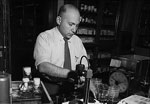Volume 30, Number 8—August 2024
Etymologia
Microbiota [mī′′-krō-bī′-ō-′tә], microbiome [mī′′-krō-bī′-ōm]
Microbiota [mī′′-krō-bī′-ō-′tә], microbiome [mī′′-krō-bī′-ōm]
From the Greek micro- (small) and -bios (life), microbiota was coined in the late 19th Century to denote the microorganisms residing in a specific environment. During the 20th Century, microbiota became more specifically associated with the microorganisms inhabiting the human body. Today, the term encompasses the collective genetic material of microorganisms, spanning viruses, archaea, bacteria, and fungi, and the intricate ecosystems of microorganisms, including commensal, symbiotic, and pathogenic ones, that exist within or on the human body or other environmental niches. Exploring microbiota and its implications in various aspects has rapidly gained momentum as a dynamic field of research.
The term microbiome was defined by Whipps and colleagues in 1988 as the collective genomes of microorganisms. However, Joshua Lederberg (Figure), a US molecular biologist, played a pivotal role in coining the term as we know it today. His journey from a precocious young scientist to a Nobel laureate and advocate for ethical science reflects the interconnectedness of language, curiosity, and scientific discovery. Lederberg’s fascination with science also extended to writing science fiction, using the genre to explore complex scientific concepts through imaginative storytelling. In fact, microbiome is a combination of microbe and biome (bi- [life] + -ome [mass]) to describe the microbial ecosystem, which encompasses not only genomes but also the broader microbial environment. Microbiome, born from the fusion of linguistic roots and a thirst for knowledge, continues to shape our understanding of the microbial world and its profound impact on human health and biology.
References
- Dorland’s illustrated medical dictionary. 32nd ed. Philadelphia: Elsevier Saunders; 2012.
- Berg G, Rybakova D, Fischer D, Cernava T, Vergès MC, Charles T, et al. Microbiome definition re-visited: old concepts and new challenges. Microbiome. 2020;8:103. DOIPubMedGoogle Scholar
- Lederberg J, Mccray AT. ‘Ome sweet ’omics—a genealogical treasury of words. Scientist. 2001;15:8–9.
- Microbiome LX. Yale J Biol Med. 2016;89:275–6.
- Marchesi JR, Ravel J. The vocabulary of microbiome research: a proposal. Microbiome. 2015;3:31. DOIPubMedGoogle Scholar
Figure
Cite This ArticleOriginal Publication Date: July 01, 2024
Related Links
Table of Contents – Volume 30, Number 8—August 2024
| EID Search Options |
|---|
|
|
|
|
|
|

Please use the form below to submit correspondence to the authors or contact them at the following address:
Daniel F.M. Monte, Department of Animal Science, College for Agricultural Sciences, Federal University of Paraiba, Areia, 58397000, Brazil
Top